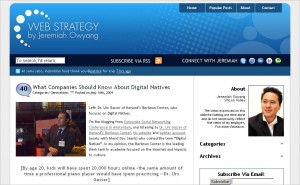Most articles, news stories and blog commentaries about social media seem to be written by someone looking through a tourist telescope, like the ones in Battery Park or on the edge of the Grand Canyon. The general approach is “Look, people are tweeting!” Or “Quick! Get in there and make money.” And at the other end of the spectrum are writers who seem to be so immersed in the social media world that they speak a secret language.
But Web Strategy by Jeremiah Owyang is one blog that’s consistently substantive without taking itself too seriously, and leading-edge instead of merely trendy. Although Owyang works for Forrester Research–which provides a lot of access–this is his personal blog, and it covers a wide rage of topics relating to how businesses can and should use the web.
There’s even a job board for “web strategist” positions, which have recently included openings for an “online connection pastor” and an SEO analyst for the Oprah Winfrey Network. Just browsing these postings provides another angle for understanding the scope and reality of social media and web presence in today’s marketplace.
I’d sum up by saying Owyang’s blog is not so much “about” the social media space as it is about thinking in a social media way. And that involves a lot more than just jumping on the Twitter-wagon. If you’re interested in really understanding the web landscape and its inhabitants, race to read What Companies Should Know about Digital Natives. This post–live-blogged from a conference on corporate social networking–explains some key factors about folks who are either born into the digital world (i.e., from 1980 on) or have arrived there as immigrants.
I’m an immigrant, of course, but I was an early homesteader on the digital frontier, so in many ways I feel more kinship with the natives than with my own generation. Though my friends and colleagues are all “computer literate,” even those who work in IT are mostly still living and thinking in the age of the individual user. Not that they don’t get their maps online, got to virtual meetings, IM like mad, and put their snapshots on Facebook! It’s just that they don’t think of the world as one big open, creative, accessible digital space.
Non-natives worry about privacy, for example, and piracy. They read newspapers (which I’m definitely not saying is a bad thing), buy physical media (CDs, DVDs, paper books), and don’t see the point of Twitter. They shop online but don’t have a PayPal account . . .
So in addition to the digital divide between those who do and those who don’t have computer access, there is also a divide between those who do and those who don’t “get” digital life. Not as in Second Life and virtual reality–which is sort of a specialty interest–and not as in the early chip-centric visions of “ubiquitous computing.” More as in Zoho instead of MS Office, Hulu instead of Tivo, and WordPress instead of Writer’s Market.
Want to recruit digital natives? Create a digital environment.
More to come.
Cynthia Giles has followed a serpentine career path from academia to publishing to marketing and design to information technology and corporate communications. There’s plenty of detail about this journey at www.cynthiagiles.com, but briefly--the common theme has been ideas, and how to present them effectively. Along the way, she became an accidental expert on data warehousing and business intelligence, and for the past ten years she has combined corporate contracting with an independent consulting practice that focuses on marketing strategy for smaller businesses and non-profits.
Having spent quite a bit of time looking for work, and anywhere from two weeks to two years inside a wide variety of American companies—she has given much thought to what works (and what doesn’t) when it comes to creating a great employment fit.
